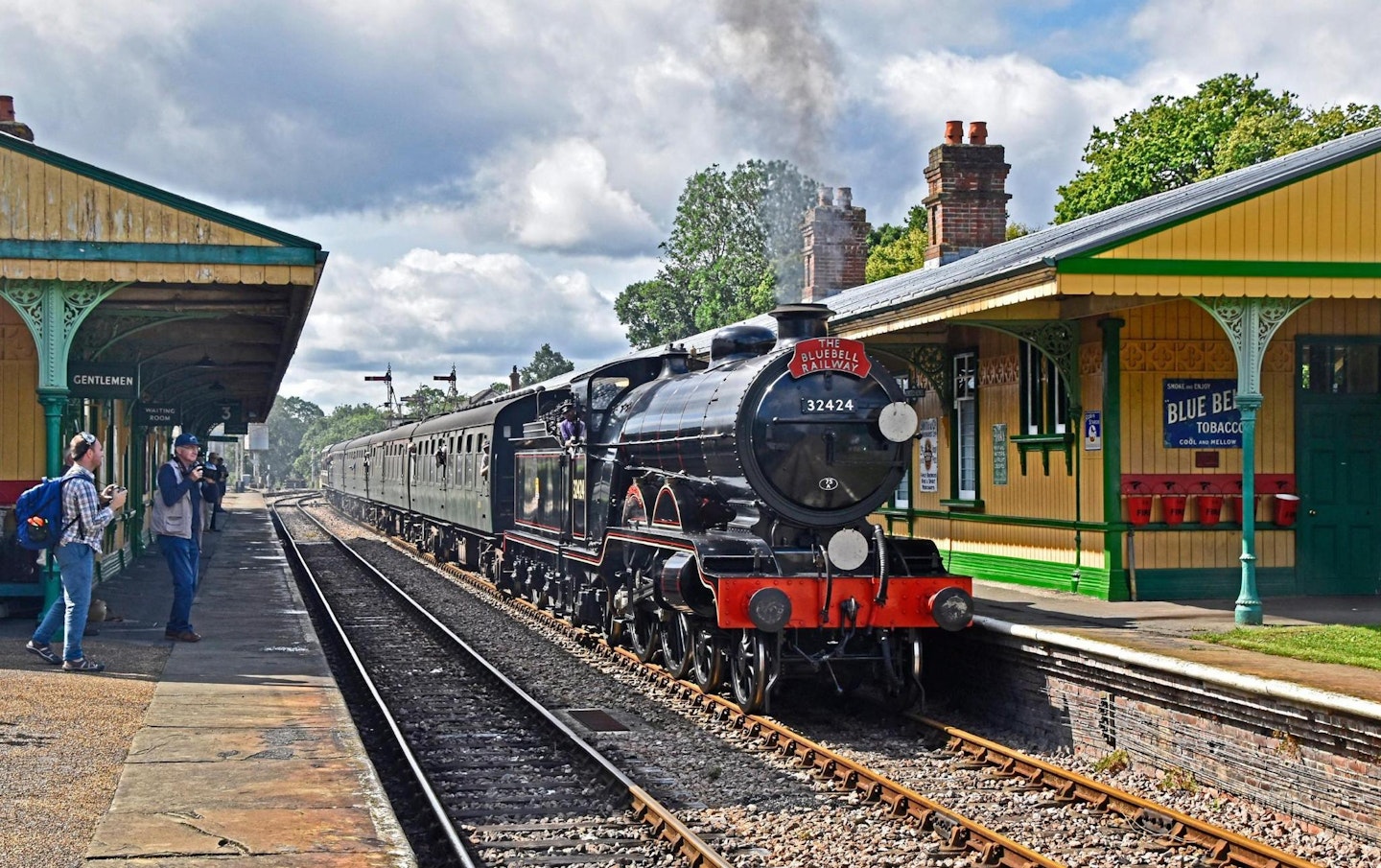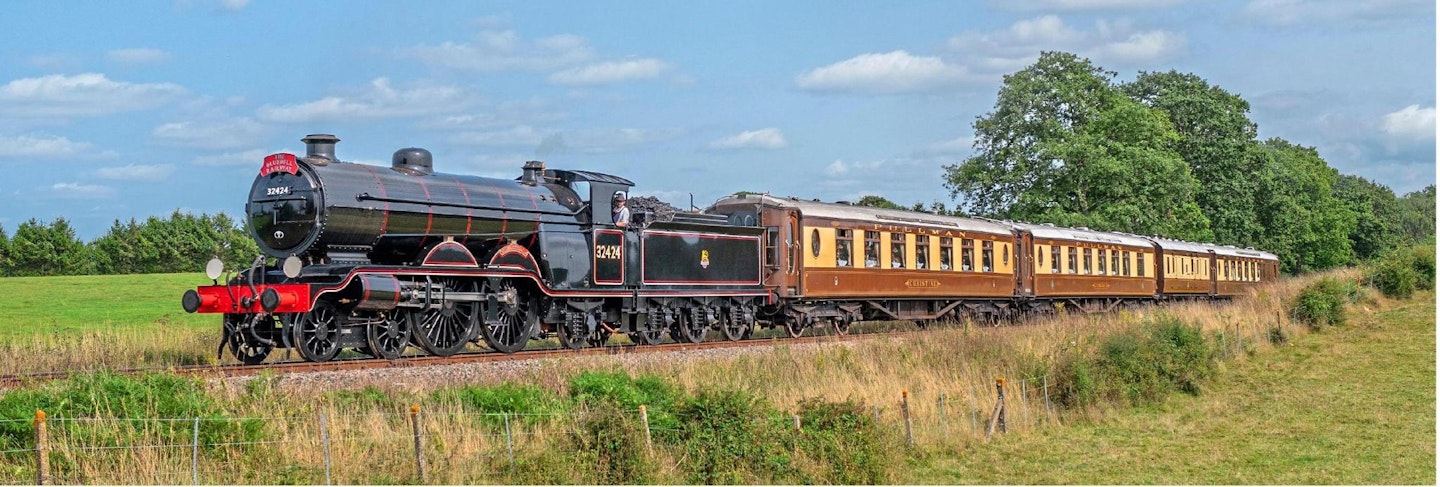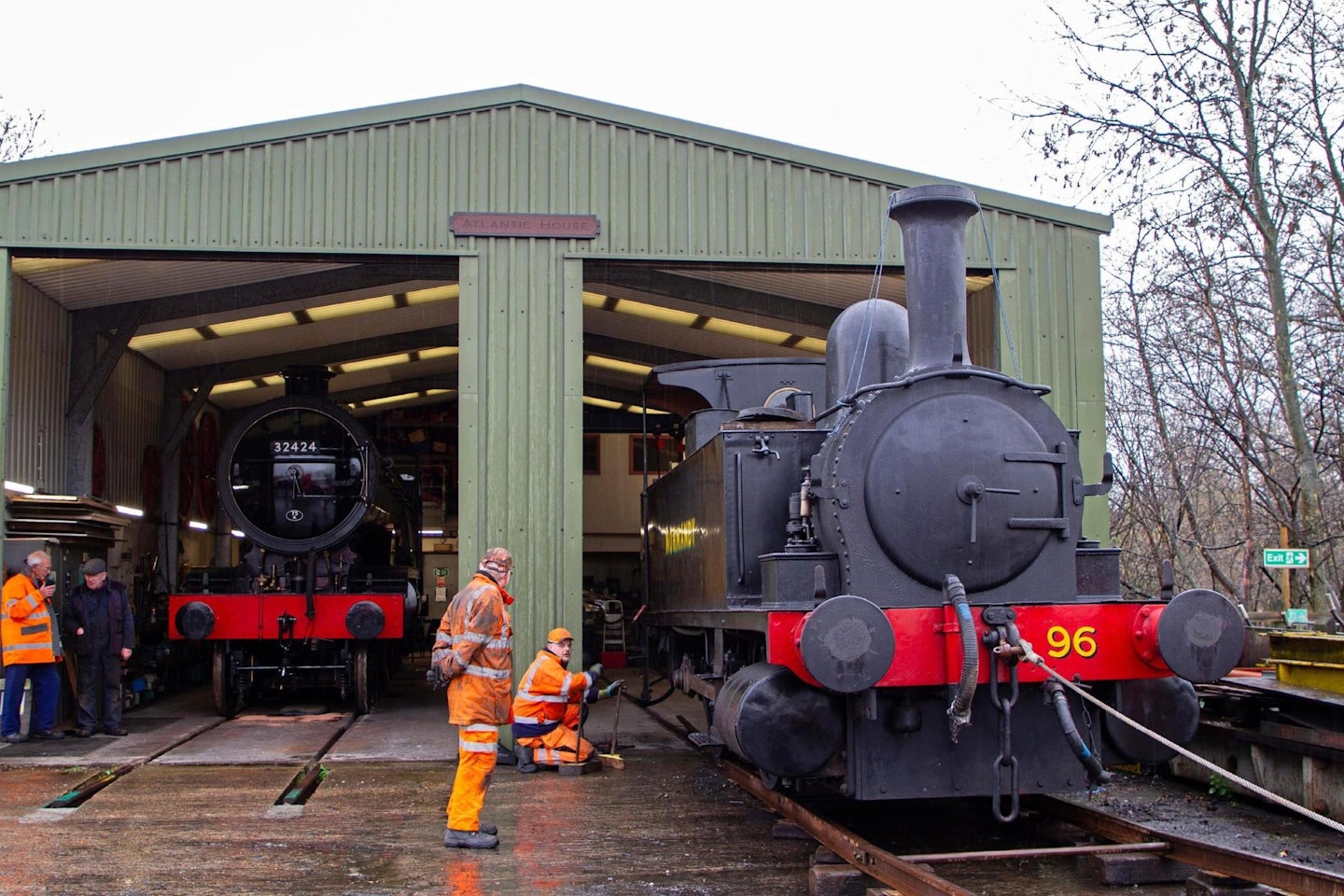After 24 years of construction, replica LBSCR ‘H2’ No. 32424 Beachy Head is finally finished and in service at the Bluebell Railway. THOMAS BRIGHT reflects on the significance of this incredible achievement, and what the future holds for its creators.

“As each week goes by, more interesting pre-Grouping classes become extinct – the loss of the last Brighton ‘Atlantic’ was an irreparable catastrophe…”.
So said the December 1959 edition of Bluebell News, the journal of the f ledgling Bluebell Railway Preservation Society. The Brighton ‘Atlantic’ in question was ‘H2’ No. 32424 Beachy Head, which was scrapped at Eastleigh shortly after withdrawal in April 1958. Had it not been for the LNER preserving Ivatt ‘C1’ No. 251 and ‘C2’ No. 990 Henry Oakley in its museum in York, Beachy Head’s scrapping would have rendered ‘Atlantics’ extinct from Britain’s railways.
Considering its status as the last 4 ‐ 4‐2 to remain in BR service, it is interesting to wonder, had it held on for just a couple more years, whether the embryonic Bluebell Railway would have saved it. It is not beyond the realms of possibility, with the line being – and remaining – a safe haven for so many unique pre-Grouping designs that otherwise would have disappeared.
The scrapping of Beachy Head and the extinction of the superb ex-LBSCR ‘H2s’ was indeed an undeniable catastrophe. But irreparable? Perhaps not…

Time warp
Fast forward 66 years and Beachy Head has been brilliantly resurrected. Following a formal handover ceremony at Sheffield Park on August 18, Britain’s newest steam locomotive finally entered public service five days later, and has just starred in the Bluebell’s Brighton-themed weekend.
But do you know what is most remarkable about No. 32424? It is not that it’s a near-perfect replica of the original ex-London, Brighton & South Coast Railway ‘H2’ in its latter-day BR guise. Nor is it the fact that it has become Britain’s first working ‘Atlantic’ in nearly 50 years, since Henry Oakley bowed out at the Keighley & Worth Valley Railway in 1978. And nor is it the fact that it is the second standard gauge new-build steam locomotive to have been completed in 2024, after Collett ‘68X X’ No. 6880 Betton Grange.
No. It’s actually how unremarkable it is. Make no mistake – the completion of Beachy Head is an astonishing achievement, one of which ever yone involved can be enormously proud. But one of the reasons it is so special is how well it blends in. It already feels like part of the furniture, as if that ‘catastrophe’ had never happened and, instead of being scrapped, had been part of the Bluebell’s f leet for the last 60-odd years. It just looks ‘right’. It’s a proper time warp. Whereas some new-build locomotives feel decidedly ‘new’ and perhaps a little pastiche, Beachy Head really feels like the real deal, as if it has always been at the Bluebell – and pulling that trick off is no mean feat.
The other remarkable thing about the Brighton ‘Atlantic’ is how undramatic its entry into service has been. There was a decided lack of hype and build-up prior to its first moves in steam at Sheffield Park on June 6. In fact, this unadvertised first steaming caught many people pleasantly by surprise, with fanfare conspicuous by its absence. Such an understated arrival is typical of a project which has always been modest – both in its ambitions and in how it conducts itself. Since day one, the project has always been clear in its intentions for Beachy Head – to create a useful locomotive for the Bluebell Railway. No fanciful notions of taking it onto the main line. No plans to modify or improve the original design. Just a faithful replica using a redundant boiler that otherwise might have gone for scrap to resurrect a long-lost and much-missed locomotive class. This clarity of focus is arguably one of the secrets behind Beachy Head’s success.

Pieces of the puzzle
So, how does it feel now that Beachy Head is finally in traffic? “It’s a bit of a relief actually,” says Brighton Atlantic Project secretary David Jones. “It’s taken so long and, of course, we had Covid as well which affected us for about two years. It has taken quite a long time to build – 24 years, in the end. But we’re quite pleased and we’ve had lots of compliments.”
While it may have taken 24 years to build – the project was formally launched at the Bluebell in October 2000 – the origins of Beachy Head are actually much older. Indeed, had it not been for the discovery by former Steam Railway editor Nick Pigott and Engine Shed Society member Steve Dymond of a pair of ex-Great Northern Railway Ivatt ‘Atlantic’ boilers at a joinery firm in Maldon in Essex in 1986, No. 32424 would never have happened. The railway had never previously harboured any ambitions of building an ‘H2’ until an appropriate boiler had been discovered, as those on the ‘C1s’ were all-but identical to those on the Brighton ‘Atlantics’. But once one of the boilers – believed to have been built in Doncaster in 1941 and fitted to ‘C1’ No. 3287 from 1943 until its withdrawal in October 1945 – had been acquired, “we then thought, ‘what shall we do with this boiler? We’d better make an engine to go with it!’.” So, was the railway ever tempted to resurrect an Ivatt ‘Atlantic’, seeing as No. 251 was – and remains – unlikely to ever run again? “Oh no! We’re a Brighton outfit, down here,” chuckles David.
The group had originally planned to number its proposed Brighton ‘Atlantic’ as No. 427 – the next in the series – but elected to replicate Beachy Head owing to both its celebrity status among enthusiasts and its links with the Bluebell, the original locomotive having run over the Lewes-East Grinstead line in steam days, as well as hauling the Kew Junction-Horsted Keynes leg of the LCGB’s ‘Southern Counties Limited’ in February 1957.
Two other factors helped unlock this project and make it viable. The first was a set of original LBSCR tender frames that had originally run behind Billinton ‘B4’ 4 ‐ 4‐0 No. 63 Pretoria, which was withdrawn in May 1951. Subsequently converted into a load bank (losing their central wheelset in the process) for diesel shunting locomotives for departmental use, the frames were acquired for the project in 1995. The second factor was the acquisition of some original LBSCR tender wheelsets. These had latterly been under the tender paired with ‘C2X’ 0 ‐ 6‐0 No. 32543 at the time of the locomotive’s withdrawal, with the tender passing into departmental use as a water tank/sludge carrier. It subsequently ended up at Woodham Bros. scrapyard in Barry, from where it was acquired in 1982 and loosely ‘Swindonised’ to become the tender behind the static replica of GWR Dean ‘Bogie Single’ No. 3041 The Queen for Madame Tussauds’ ‘Royalty & Empire Exhibition’ at Windsor station. While the tender was later scrapped, the wheelsets, springs and axleboxes ended up at a scrap merchants in Uxbridge, before being acquired by the Bluebell in 1999. Thus, like Betton Grange, Beachy Head incorporates a fair amount of original material.
Devil in the detail
Even though these components gave the project a healthy head-start, what have been the biggest challenges in building Beachy Head? “Some people think it was the money, but the money was coming in quite well – it’s a popular project. Most of the Bluebell’s membership was behind it. One or two said, ‘It’s not really a Brighton engine, is it, because it’s got a Great Northern boiler’, but to build a new Brighton-pattern boiler would have been quite expensive, so it’s been useful to use the existing boiler.”
Beachy Head certainly looks and sounds like the real deal, but just how authentic a replica is it, considering that the boiler is, strictly speaking, a GNR example and not a true LBSCR one?
“The firebox is about three inches deeper [than on the original Beachy Head] but we knew that, and Fred Bailey, who did all the drawings, modified the drawings to suit. Apart from that, the boiler fitted quite well,” says David.
“We’ve had to change things a bit, of course. Originally, the coupling rods – for instance – would have been forgings. We couldn’t get forgings made, so we’ve had to use the water jet method, which is interesting as we’ve had enquiries from people as far away as Sweden asking us how we got our rods made.”
There have been some other changes as well, largely owing to operational necessity. The first has been the braking system. Beachy Head – like the original ‘H2s’ – is air-braked, whereas the Bluebell’s rolling stock is all vacuum-braked, which has necessitated the fitting of proportional valves on the locomotive and in the tender to convert the air pressure into vacuum. “They’ve got fairly f lexible diaphragms in there, and we’ve had to replace those with stiffer diaphragms to make it work properly.”
The other has been the provision of steps on the rear of the tender because of concerns raised by the Office of Rail & Road. “They weren’t too happy with the access to the tender for filling the water,” explains David. “In the old days, the crew would come from the cab and walk across the coal to get to the tender filler cap. They didn’t like that, so we’ve fitted some steps up the back of the tender, which is not original, but most people probably won’t realise.”

Aside from these minor differences, Beachy Head is pretty much as Douglas Earle Marsh designed it (although, strictly speaking, the ‘H2s’ were introduced under the auspices of Marsh’s successor, Lawson Billinton). “It’s very close, actually,” says David, “as we used the original drawings from the National Railway Museum.” For instance, the cab roof has been built in two parts, like the original ‘H2s’, as the rear part was designed to be removed to make way for lifting chains if the locomotive was ever craned off the rails. Likewise, the tender is double-skinned, as per the original drawings. “That was an odd Brighton idea,” says David, “so they wouldn’t have any rivets showing, as they wanted it to look very smooth on the outside.” One minor concession to modernity in this respect is that the inner skin is welded rather than riveted, but the fact the group has gone to the trouble of fitting a double skin in the first place when it makes no external difference shows their dedication to authenticity.
With all this attention to detail, what is the group most proud of? “I think we’re most proud of the support we’ve had from the Bluebell membership. Most of the funding has come from that.
I remember going to the Epping Ongar Railway and visiting the ‘Patriot’ stand, and they said, ‘We have to have these sales stands everywhere, otherwise we couldn’t proceed’. We’ve never had a sales stand, apart from the one in Atlantic House – and that was mainly for people coming in to see how we were getting on. We’ve been quite fortunate with the money; we’ve had one or two legacies, of course. One of the chaps who left us a large amount of money had also been sponsoring items previously, so he’s added quite a lot to the total.”
That total for completing Beachy Head, as it happens, is estimated at £1.4 million. When you consider that some overhauls of existing locomotives are more frequently costing similar amounts – indeed, Blue Peter’s recent overhaul cost an estimated five million pounds – No. 32424 is an absolute bargain.
Two for one
Now that Beachy Head is finished and under the care of the Bluebell’s operating department, what’s next for the group? For a long while, it was going to have been a second new-build locomotive – specifically, a South Eastern & Chatham Railway ‘E’ class 4 ‐ 4‐0.

“The original idea was to build a LBSCR ‘K’ class ‘Mogul’,” says David. “That would have been lovely, but having looked into it and realising that we’d never have seen the end of it because it would have taken so long, we decided to abandon that. And then this idea of an ‘E’ class came up. That was largely to do with the fact that it had similar parts to the ‘C’, ‘H’ and ‘O1’, so we thought we could combine things and build an ‘E’. It would have been quite a useful engine – even though it wasn’t LBSCR – but in the end we decided that it was going to be too big a job.
“So, we looked at other ideas, and there’s always been pressure on the Bluebell to get the Adams ‘Radial’ overhauled, so we thought we’d take that on instead. There wasn’t that much support for the ‘E’ actually, from within the Bluebell’s membership – they’re mainly Brighton people!”
Around the time the group decided to overhaul No. 30583, the Bulleid Society – which owns Bluebell-based ‘West Country’ No. 21C123 Blackmore Vale – approached them to see if it’d be interested in also taking on the overhaul of the society’s other locomotive, ex-LSWR ‘B4’ 0 ‐ 4‐0T Normandy (another Adams design) as a contract job. “The money was already available, so that was a plus point,” says David, “so we’ve decided to do both.”
For fans of the ‘Radial’, don’t expect the former Lyme Regis branch veteran to be making its much ‐anticipated comeback anytime soon, as the current priority is Normandy. The former Southampton Docks shunter is already largely dismantled inside the group’s Atlantic House workshop at Sheffield Park, with the boiler expected to be lifted from the frames very soon. “Then we can assess and see what’s needed and go ahead with the overhaul.”
As for No. 30583, “we can’t really do much until the money comes in, because that’s going to be quite expensive – probably more expensive than we think because we don’t know what the boiler is like. It might be the case of fitting a new boiler, which is not a problem, because we can get a boiler made; it’s just a question of money.”
David adds: “We hope Normandy will be finished in three years’ time, and then we’ll start dismantling the ‘Radial’.”
Though the Adams ‘Radial’ may still be some years away from steaming again for the first time since 1990, had the Brighton ‘Atlantic’ group not decided to take it on, we’d have to wait even longer. “If we’d gone ahead with the ‘E’ class, nothing would have been done to the Adams – to either of the Adams engines, actually. In some respects, it’s been advantageous to both the ‘Radial’ and Normandy to abandon the ‘E’ class.”
However, that’s not to say the ‘E’ is totally dead and buried. “We’ve left it so that, in the future, if anyone wants to build an ‘E’, there are parts available, because we collected lots of bits in Atlantic House.”

Atlantic legacy
Arguably, neither Beachy Head nor the revival of both Normandy and the Adams ‘Radial’ are the greatest legacy from this project. It is, perhaps, the place that enabled these achievements to take place – Atlantic House.
“The first thing we always say to these new ‐build groups that come to see us is: ‘You must have a building’. When we started on the tender, we did it outside and when it rained we couldn’t do anything, and we thought, ‘We can’t progress without a building’. So that’s why we concentrated on building Atlantic House, and we were fortunate that the Bluebell Railway Trust funded most of it.
“It’s been a boon really, because we could just down tools and walk out, lock the door, come back the following day, and carry on.”
Looking back now, would the group have done anything differently? “I don’t think we would, really,” says David. “We were under a bit of pressure to get Beachy Head finished because it took a bit longer than we’d anticipated. That caused a few hiccups with the people who were working on it, as they weren’t happy with being pushed, but in the end they were pleased that they managed to finish it. But I don’t think we’d do anything differently.”

Worth the wait
It’s a sentiment many would agree with: Beachy Head has been a superb achievement, and a very welcome addition to the Bluebell Railway’s fleet. The Brighton Atlantic Group has gone about its project without fuss, and the result is nothing short of astonishing. And its success means two more pre-Grouping veterans that might have otherwise remained in the overhaul queue – Normandy and the Adams ‘Radial’ – are getting a second lease of life. It may have taken nearly 70 years to undo that ‘irreparable catastrophe’, but goodness it was well worth the wait.

